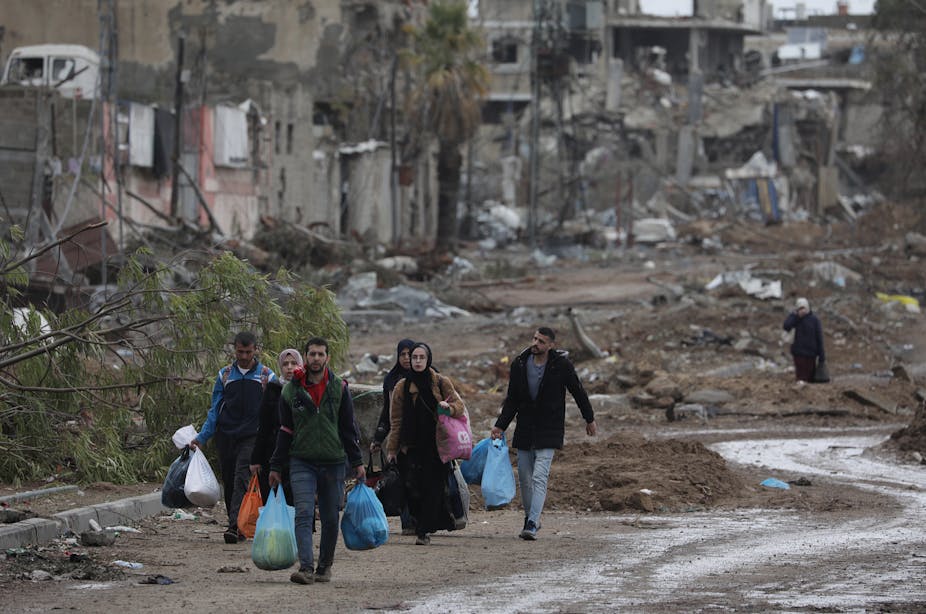Hamas’s attack on Israel on October 7 marked the beginning of a fresh round of conflict between Israel and Palestine. But it also raises the question of how we should assess Hamas’s terrible crime and whether and how it can be put into context compared with other war crimes committed by other parties.
Many people believe that we should not “relativise” it (or any other terrible terrorist action). But comparing horrific acts and putting then into context allows us both to understand them and to arrive at a reasonable ethical judgment.
You can listen to more articles from The Conversation narrated by Noa.
This seems to be the view also of the author and peace activist David Grossman, who made the following comparison: “The occupation is a crime, but to shoot hundreds of civilians – children and parents, elderly and sick in cold blood – that is a worse crime. Even in the hierarchy of evil, there is a ‘ranking’.”
This is relativisation, but not one that is very helpful. To compare the terrorist act of Hamas with the occupation is to compare apples with oranges.
More valuable would be a comparison between the Hamas terrorist action (and violation of the laws of armed conflict) and Israel’s killing of civilians in general and children in particular. Which crime is worse? Which crime ranks highest in the hierarchy of evil?
Read more: Where the ICC stands if war crimes are committed on either side of the Israel-Hamas war
What the law says
The assessment of Hamas’s crime is straightforward and simple. They targeted innocent people, killed or kidnapped them. Even if the Palestinians have a right to resistance against the occupiers (they enjoy what is called jus ad bellum – the right to make war) not all means are permitted.
Even defensive wars must be conducted in a proper way. It is never permissible to target civilians to defeat your enemy. That is part of what is called jus in bello (the law of war) which is binding for both those who attack and those who defend themselves.
What about Israel’s attacks on Gaza, then? Israel upholds an illegal occupation of Gaza and the rest of the Palestinian territory and has put Gaza under siege – something forbidden in international law since 1977. What’s more, their attacks on Gaza, where the explicit target is Hamas, cause casualties among civilians – not least among children.
According to humanitarian law, it is permitted to target military installations even if it means that some civilians are killed. But this must not be done if the number of civilian losses is disproportionate in relation to the military goal.
This line has arguably been transgressed already in the present Israeli war on Gaza. The casualties appear out of proportion.
The assessment of proportionality is not an exact science and few precedent cases exist. In the final analysis, it is a matter of judgment.
When the UN secretary general, António Guterres asserted, “I am deeply concerned about the clear violations of international humanitarian law that we are witnessing in Gaza,” it was clear that this was addressed partly to Israel (who protested). It is easy to concur with his judgment, given the way the war has developed.
But is there not an important difference here? While Hamas has targeted civilians, Israel kills them without any intention to do so. The number of dead civilians is out of proportion, but their death is merely predictable – not intended. Does this not mean that Israel’s crime ranks lower in the hierarchy of evil?
This assessment is also too simplistic. When they go after Hamas knowing they will kill a disproportionate number of civilians, it is appropriate to impute to them an indirect intent to kill these civilians. We may speak in legal terms of an intent rooted in a reckless indifference to human life.
Moral judgments
What is worse then, to kill civilians directly and intentionally in rage, or indirectly, from a distance, with reckless indifference to human life?
If we base our comparison on a concern for civilians in and around armed conflicts, it is appropriate to count the casualties. What kind of crime takes the largest toll? What can we learn from modern history?

For example, the US-led war in Indochina – where most of the killing was indirect and conducted from a distance out of reckless indifference to human life – set records in the killing of civilians since the second world war. The dead must be counted in the hundreds of thousands and the bombing campaign that killed them has been called a war crime.
Certainly, there is considerable weight also on the other side of the argument, that intentional civilian deaths are worse. Just think of the genocide in Rwanda or the deliberate and murderous ethnic cleansing of the Balkans in the 1990s.
There are a lot of other examples. The massacres of Rohingya Muslims in Myanmar, the Yazidis in Iraq, the Janjaweed massacres in Darfur in the 2000s and again as part of the recent explosion of viollence in Sudan – recent history is replete with indiscriminate killing of civilians.
And yet, when the casualties are counted, it is perhaps safe to claim that indirect killing at a distance with a reckless indifference to human life is no better. Worse in one respect: it seems to be so easy to perpetrate.
What should Israel do if they cannot respect jus in bello? If only the alternative to never-ending war could be as simple and straightforward as one democratic state for everyone who lives within the territories currently controlled by Israel, where Jews, Muslims and Christians can live together. This may seem as a piece of wishful thinking during the height of armed conflict, but since it now appears to be the only realistic way of ending hostilities, there is hope for the future.

